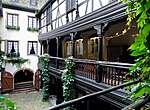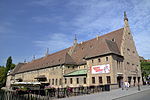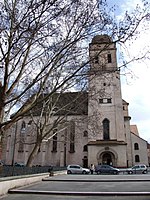Battle of Strasbourg
The Battle of Strasbourg, also known as the Battle of Argentoratum, was fought in 357 between the Western Roman army under the Caesar (deputy emperor) Julian and the Alamanni tribal confederation led by the joint paramount King Chnodomar. The battle took place near Strasbourg (Alsace, France), called Argentoratum in Ammianus Marcellinus' account, Argentorate in the Tabula Peutingeriana (Section 2). Although possibly outnumbered, the Roman army won a decisive victory after a hard-fought struggle with the Alamanni. With negligible casualties of their own, the Romans drove the Alamanni beyond the river, inflicting heavy losses. The Roman force, the imperial escort army of Julian, was small but of high quality. The battle was won by the skill of the Roman infantry, with the Roman cavalry initially performing poorly. The battle was the climax of Julian's campaigns in 355–57 to evict barbarian marauders from Gaul and to restore the Roman defensive line of fortifications along the Rhine, which had been largely destroyed during the Roman civil war of 350–53. In the years following his victory at Strasbourg, Julian was able to repair and garrison the Rhine forts and impose tributary status on the Germanic tribes beyond the border.
Excerpt from the Wikipedia article Battle of Strasbourg (License: CC BY-SA 3.0, Authors).Battle of Strasbourg
Parc de l'Étoile, Strasbourg Neudorf
Geographical coordinates (GPS) Address Nearby Places Show on map
Geographical coordinates (GPS)
| Latitude | Longitude |
|---|---|
| N 48.573805555556 ° | E 7.7521666666667 ° |
Address
Centre Administratif Ville et Eurométropole de Strasbourg
Parc de l'Étoile 1
67076 Strasbourg, Neudorf
Grand Est, France
Open on Google Maps









